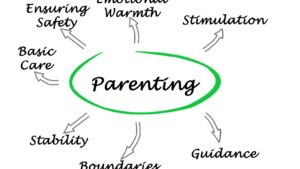Ex-toc When the dust settles after a divorce, it’s often the children who bear the brunt of the storm. But what if there was a way to co-parent that minimizes conflict and keeps the focus on the kids? Welcome to the world of parallel parenting.This approach, growing in popularity, offers a fresh perspective on navigating the often choppy waters of shared custody. It’s about disengaging from the ex-spouse while staying fully engaged with the kids. Intrigued? Let’s dive deeper into the concept of parallel parenting and explore how it could be the life raft you’ve been searching for in your post-divorce journey.
When the dust settles after a divorce, it’s often the children who bear the brunt of the storm. But what if there was a way to co-parent that minimizes conflict and keeps the focus on the kids? Welcome to the world of parallel parenting.This approach, growing in popularity, offers a fresh perspective on navigating the often choppy waters of shared custody. It’s about disengaging from the ex-spouse while staying fully engaged with the kids. Intrigued? Let’s dive deeper into the concept of parallel parenting and explore how it could be the life raft you’ve been searching for in your post-divorce journey.
Parallel Parenting
 Parallel parenting, an increasingly favored approach following divorces, warrants closer examination. It operates on the premise of disengagement from the ex-spouse, contrary to conventional co-parenting methods, while ensuring unwavering engagement with the children. I will delve into the crucial elements that make this approach work and provide actionable parenting tips to implement them in daily life.Embracing minimal communication forms one vital strand of parallel parenting. Ex-spouses interact minimally, restricting conversations to written communication – emails or texts – focusing strictly on the children. Understanding this, you pave the way for a less stressful environment, beneficial for you and, significantly, for your children’s health and overall well-being.Furthermore, maintaining separate parenting styles, another facet of parallel parenting, promotes personal autonomy.
Parallel parenting, an increasingly favored approach following divorces, warrants closer examination. It operates on the premise of disengagement from the ex-spouse, contrary to conventional co-parenting methods, while ensuring unwavering engagement with the children. I will delve into the crucial elements that make this approach work and provide actionable parenting tips to implement them in daily life.Embracing minimal communication forms one vital strand of parallel parenting. Ex-spouses interact minimally, restricting conversations to written communication – emails or texts – focusing strictly on the children. Understanding this, you pave the way for a less stressful environment, beneficial for you and, significantly, for your children’s health and overall well-being.Furthermore, maintaining separate parenting styles, another facet of parallel parenting, promotes personal autonomy.
Understanding Parallel Parenting and Its Purpose
The ex-spouses can independently navigate the challenges and triumphs of raising their kids without constant negotiations, compromises, or confrontations. Such a strategy reduces conflict and fosters a sense of stability for the kids, establishing coherent parenting strategies minus the tussle.
 Dipping my toes further into the concept, I found a wealth of insights to unlock. If a person has tuned into the discourse around parent-child relationships in post-divorce scenarios, the term ‘parallel parenting’ is unlikely to be new.
Dipping my toes further into the concept, I found a wealth of insights to unlock. If a person has tuned into the discourse around parent-child relationships in post-divorce scenarios, the term ‘parallel parenting’ is unlikely to be new.
Parallel parenting exists as an effective post-separation strategy, where parents detach themselves from each other while staying connected with their kids. Considering this parenting approach, it’s like running parallel lanes in a race – each parent pursues their parenting style, unencumbered by the other’s influence, yet focused on the shared finish line of their child’s well-being. Addressing the disconnection between the parents, this method restricts communication to important child-related matters only, typically channeled through a mediator, thus minimizing the possibility of conflict.
 Among the diverse range of parenting tips, many people adopt parallel parenting for its unique benefits. Here are some of the primary reasons:
Among the diverse range of parenting tips, many people adopt parallel parenting for its unique benefits. Here are some of the primary reasons:
- Maintains Emotional Health: First, high conflict situations put a strain on everyone involved, especially the kids. The reduction of communication in parallel parenting helps in maintaining emotional health by limiting the exposure of children to hostilities.
- Promotes Individual Parenting Styles: Separate lanes mean freedom for parents to adopt their unique parenting styles. This autonomy supports a healthier post-separation environment, crucial for the children and the parents themselves.
- Business-like Approach to Parenting: By switching to a business-like approach, parents cast aside emotional baggage, focusing purely on the responsibility of child-rearing. Decision-making becomes efficient, directive, and less stressful, driven by the children’s best interest.
 Parallel parenting offers numerous benefits that help create an efficient and conflict-free relationship with the ex-spouse while ensuring the well-being of the children. Read on to learn more about some of its benefits.
Parallel parenting offers numerous benefits that help create an efficient and conflict-free relationship with the ex-spouse while ensuring the well-being of the children. Read on to learn more about some of its benefits.
Thus, parallel parenting serves as an underutilized yet highly beneficial approach, bridging the gap between parental separation and the children’s well-being. It presents a cultivative environment that nurtures growth, resilience, and adjustment, despite the challenges of a post-divorce scenario.
Reduced Conflict and Tension
One primary benefit of parallel parenting is a steep reduction in conflict and tension between parents post-divorce. Parents interact less, limiting the scope for any potential disputes. Designating specific aspects of parenting to each parent also cuts down the chances of disagreements. For instance, if one parent is in charge of the child’s education and the other of the child’s health, then each parent has clear demarcation of responsibilities. This model helps eliminate the scope for confrontations on these topics, hence relieving tension.
 Parallel parenting also encourages individual parenting styles. Each parent can apply their style and methods without the fear of being critique or judged by the other. For example, one parent might emphasize discipline and structure, while the other may promote creativity and flexibility. Children get exposure to different styles and perspectives, which can contribute to a well-rounded upbringing.
Parallel parenting also encourages individual parenting styles. Each parent can apply their style and methods without the fear of being critique or judged by the other. For example, one parent might emphasize discipline and structure, while the other may promote creativity and flexibility. Children get exposure to different styles and perspectives, which can contribute to a well-rounded upbringing.
Arguably the most significant benefit of parallel parenting is its positive impact on children’s emotional stability. The focus shifts from marital discord to providing a wholesome and nurturing environment, which helps children adapt to the new family dynamic. Without the constant bickering and tension between parents, children experience less anxiety, stress, and emotional turmoil.
Parallel Parenting vs Co-Parenting
As a result, they are better equipped to navigate their emotions and can concentrate on their personal growth and development.Benefits such as reduced conflict, the opportunity for individual parenting styles, and fostering children’s emotional stability make parallel parenting an effective method in managing post-divorce parenting.
 Navigating the subtleties of parenting post-divorce poses challenges. It’s critical to assess various strategies, notably parallel parenting and co-parenting, to find the ideal approach.
Navigating the subtleties of parenting post-divorce poses challenges. It’s critical to assess various strategies, notably parallel parenting and co-parenting, to find the ideal approach.
The primary distinction between parallel parenting and co-parenting centers around the level of communication and collaboration.
In parallel parenting, parents adopt separate parenting styles without regular interplay. It’s a low-conflict approach reducing the need for constant interaction. There’s minimal communication limited only to pertinent issues around children’s health, education, and welfare. Decisions are made independently, ensuring a business-like approach. Imagine parallel parenting as two lanes on a road, operating independently but reaching the same destination.
Which One is Right for You?
Contrastingly, co-parenting involves maintaining a high level of communication and collaboration. Parents share parental responsibilities while fostering consistent parenting norms across households. Regular interaction is vital to keep both parties informed about child-related issues.
 Determining the right strategy depends on the unique circumstances surrounding your relationship with your ex-spouse.Parallel parenting works best when the level of conflict remains high, making seamless interaction difficult. It’s an approach that allows both parents to be involved while minimizing conflict and stress. It’s a sound choice if maintaining emotional health and adopting individual parenting styles are priorities.On the other hand, co-parenting may work better when parents can maintain effective communication and work harmoniously towards the betterment of the child. It promotes familial consistency, which can be crucial for a child’s development.
Determining the right strategy depends on the unique circumstances surrounding your relationship with your ex-spouse.Parallel parenting works best when the level of conflict remains high, making seamless interaction difficult. It’s an approach that allows both parents to be involved while minimizing conflict and stress. It’s a sound choice if maintaining emotional health and adopting individual parenting styles are priorities.On the other hand, co-parenting may work better when parents can maintain effective communication and work harmoniously towards the betterment of the child. It promotes familial consistency, which can be crucial for a child’s development.
How to Make Parallel Parenting Work
In both models, the prime intent stays focused on minimizing the negative effects of divorce on children’s emotional health and stability. The best choice depends essentially on interspousal dynamics, conflict levels, and the commitment to creating a safe, nurturing environment for the children.
 Transitioning from a relationship to a parallel parenting model isn’t a walk in the park. However, with a well-thought-out plan and effective communication methods, it’s possible to ensure your kids get the best of both worlds.
Transitioning from a relationship to a parallel parenting model isn’t a walk in the park. However, with a well-thought-out plan and effective communication methods, it’s possible to ensure your kids get the best of both worlds.
Devising a solid and comprehensive parallel parenting plan forms the backbone of this approach. It’s the roadmap that guides you and your ex-spouse to ensure children don’t bear the brunt of any disharmony.
- Clearly lay out daily routines such as mealtimes, bedtimes, and study hours in the plan.
- Highlight calendar events like vacations, holidays, school functions, and medical appointments.
- Specify each parent’s responsibilities, ranging from education to health needs, extra-curricular activities to leisure time.
- Clearly establish the rules for emergency situations and unexpected changes in plans.
Communication Tips
A parenting plan acts as an agreement that remains pivotally unique to each family’s circumstances. Therefore, there’s no harm in seeking expert advice to tailor it to your needs.
 We’ve established that parallel parenting limits communication, and most interactions emulate a business model. However, the health of your child is the mission statement in this business model, and prescribed communication tips can serve as the SOP (standard operating procedures) to steer clear of conflicts.
We’ve established that parallel parenting limits communication, and most interactions emulate a business model. However, the health of your child is the mission statement in this business model, and prescribed communication tips can serve as the SOP (standard operating procedures) to steer clear of conflicts.
- Keep your emotions in check while talking. Let only relevant issues take center stage.
- Shunning face-to-face communication, opting for text or email, reduces emotional triggers.
- Document all communication references, from school reports to medical bills, as these serve as buffers in potential disagreements.
- Always focus on the child’s welfare. Any hint of personal grievances or past spats can derail the parallel parenting journey.
These parenting tips are not bookish rules but proven ways to keep the children’s interests at the forefront. The ultimate key is to always remember that you’re doing this for your child’s well-being, which can make even a business-like approach feel like a labor of love.
Challenges of Parallel Parenting and Overcoming Them
Navigating the uncharted waters of parallel parenting isn’t always smooth sailing, despite its many benefits. Like any other parenting method, it presents its fair share of challenges.
 However, being aware of these difficulties and adopting strategies to manage them can make all the difference.
However, being aware of these difficulties and adopting strategies to manage them can make all the difference.
For one, the absence of regular, open communication can sometimes lead to misunderstandings or misconceptions. Miscommunication can escalate conflicts, thereby deteriorating the relationship even further. In addition, maintaining completely separate parenting styles can cause inconsistencies in the child’s routine and discipline, which might result in confusion and instability.Another hurdle is engaging in minimal joint decision-making. On major issues about the children’s lives, important decisions must be made collectively. The lack of communication might mean not always being on the same page, leading to potential disagreements.
 To tackle these challenges, a few parenting tips might come in handy. For starters, clarify communication methods and frequency in the parenting plan. Stick to communication about the child’s welfare alone, avoiding personal issues. This clarification reduces the scope for misunderstandings, managing conflict better.Next, while it’s okay to have separate parenting styles, establish common ground on crucial routine and disciplinary matters. Consistency, in large part, fosters a sense of security and stability for children.
To tackle these challenges, a few parenting tips might come in handy. For starters, clarify communication methods and frequency in the parenting plan. Stick to communication about the child’s welfare alone, avoiding personal issues. This clarification reduces the scope for misunderstandings, managing conflict better.Next, while it’s okay to have separate parenting styles, establish common ground on crucial routine and disciplinary matters. Consistency, in large part, fosters a sense of security and stability for children.
Stories from Parallel Parents
Exploring the world of parallel parenting, we’d gain insights into the realities faced by parents who’ve made this choice. Their experiences paint a picture that plays a significant role in helping others navigate the complexities of this method.
 Tales of numerous parallel parents reveal invaluable lessons. An interesting story includes that of a contract worker mom who made a conscious decision to adopt the parallel parent style swiftly after her divorce, citing it as one of her most profound health decisions.
Tales of numerous parallel parents reveal invaluable lessons. An interesting story includes that of a contract worker mom who made a conscious decision to adopt the parallel parent style swiftly after her divorce, citing it as one of her most profound health decisions.
- Structured Communication: She noticed lesser miscommunication with her ex-spouse as an outcome of primarily email-based interaction, which allowed them to document and articulate their decisions clearly.
- Better Coping Mechanism: The disengagement from her ex-spouse enabled her to manage her emotions better and avoid the stress that ordinarily came from face-to-face encounters.
- Room for Parental Styles: The freedom to adopt her unique parenting style without indulging in constant comparisons gave her the confidence to overcome the hurdles that came her way.
- Clear Boundaries: She initially faced difficulties in upholding boundaries and asserting the business-like approach before her ex-spouse but eventually managed to establish ground rules effectively.
Success Stories
These experiences illustrate the need for pertinent parenting tips and strategies to meet success in parallel parenting.
 Success stories in the realm of parallel parenting revolve around the positive impact on the children. A business executive dad, for instance, shared that his children exhibited significant improvements in their overall well-being and academics since he adopted parallel parenting.
Success stories in the realm of parallel parenting revolve around the positive impact on the children. A business executive dad, for instance, shared that his children exhibited significant improvements in their overall well-being and academics since he adopted parallel parenting.
- Children’s Well-being: The minimized exposure to conflicts improved the emotional health of their children phenomenally.
- Emotional Stability: His children experienced stability as they began feeling secure amidst the separate homes and parenting styles.
- Healthy Role Modeling: The children also picked up valuable lessons about handling disagreements and maintaining respect from their parents’ parallel parenting approach.
These stories affirm that parallel parenting, despite initial obstacles, can lead to successful and healthy co-parenting. They depict that with appropriate strategies and mindset, needless conflicts and stress come secondary to the supreme goal: providing a nurturing environment for the children.


